Plant Profiles
Click on the first letter of the common name of the plant you wish more information about.
A | B | C | D | E | F | G | H | I | J | K | L | M | N | O | P | Q | R | S | T | U | V | W | X | Y | Z
L
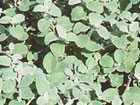
Licorice Plant
Scientific Name: Helichrysum petiolare
Growth Habit: A sprawling evergreen perennial growing to 20 inches tall and more than 24 inches in diameter. The leaves are oval and silvery with a feltlike texture growing to 1 inch long and wide.
Light: Plant in full sun to light shade.
Feedings: Apply a general garden fertilizer to in-ground plantings monthly; feed container plantings every other week with a 20-20-20 or similar product following label instructions.
Water Needs: Drought tolerant for short periods of time; grows best when watered as the surface soil begins to dry.
Ease of Culture: Easy.
Propagation: Start plants from cuttings.
Hardiness: Tender but needs the cooler weather for best growth. Protect from frost and freezes.
Major Problems: Plantings are overcome by Florida's summer rains and heat, which encourage rot problems. Grow in a well-drained soil and locations with good air movement to prevent decline.
Pruning: Encourage full compact plants by periodically pinching the ends of stems. Also keep shoots in bounds by trimming as needed.
Uses: An attractive ground cover usually grown as an annual for the cooler and drier months October through May. Set plants about 2 feet apart to grow a blanket of silvery foliage that contrasts with other brightly colored garden flowers. Perhaps one of the best uses is in planters and hanging baskets to serve as a filler cascading over the edges of the containers contrasting with flowers and other foliage plants. When under a bit of drought stress, the foliage gives off a faint licorice fragrance giving rise to its common name. After extended periods of growth, plantings may produce creamy white flowers that are overshadowed by the attractive foliage.
Florida Native: No; native to South Africa.
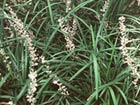
Lily Turf
Scientific Name: Liriope muscari
Growth Habit: A clump-forming perennial with upright to arching leaves growing to 18 inches tall. The leaves are dark green, long and narrow, arising from buds near the ground.
Light: Plant in full-sun to lightly shaded locations.
Feedings: Apply a general garden fertilizer once monthly in March and June.
Water Needs: Drought tolerant. Water frequently until the plants become rooted into the surrounding soil. Once established, plants can usually exist with seasonal rains.
Ease of Culture: Easy.
Propagation: Start plants by dividing older clumps.
Hardiness: Hardy.
Major Problems: Crown rot has become a major cause for decline when plants are grown in moist areas or are overwatered. Plant in locations with good air movement, and water only during severe drought to prevent decline. Plantings also may be attacked by scale, which can be controlled with an oil spray.
Pruning: Planting along walkways may need periodic trimming to keep them in bounds. During severe winters, the ends of leaves may be damaged, and the plants can be sheared to remove the brown look.
Uses: A reliable ground cover for Florida landscapes. Plantings often are substituted for turf, grown as a low-maintenance ornamental to fill in between shrubs or added to water-wise landscapes with other drought-tolerant selections. Plantings produce stalks of lavender to white blooms among the leaves June through September. A number of selections are available, including Super Green Giant.
Florida Native: No; native to China and Japan.
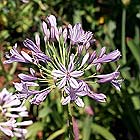
Lily of the Nile
Scientific Name: Agapanthus africanus
Growth Habit: A perennial, evergreen, bulblike plant composed of leaves growing from a central bud near the ground. The leaves are strap- like in shape and bright- to deep-green in color, growing to 24 inches long and 2 inches wide.
Light: Plant in full sun to light shade. Those in full sun usually flower best.
Feedings: Apply a general garden fertilizer once monthly in March, June and September.
Water Needs: Drought tolerant; grows best with a 3- to 4-inch mulch layer and when watered every seven to 10 days.
Ease of Culture: Easy.
Propagation: Start plants from seed or by division of older clumps.
Hardiness: Hardy; foliage may be damaged by freezing weather, but new leaves grow from buds near the ground.
Major Problems: Caterpillars, grasshoppers and other chewing insects may damage the foliage, but they can be handpicked and destroyed if needed. Mites also may affect the foliage, but they can be controlled with a soap spray.
Pruning: Remove damaged foliage and older declining leaves during late winter as growth begins. Also remove leaves that droop to the ground and interfere with nearby plantings during the growing season. Remove flower stalks when the blossoms decline.
Uses: One of Florida's more reliable bulblike flowers to grow as a ground cover or as an addition to the perennial garden. The flowers vary in color from snow white to deep blue, opening in ball-shaped clusters atop 3-foot-tall stems April though June. Dwarf selections are also available with compact growth habits for the smaller gardens and for container culture.
Florida Native: No; native to Africa.
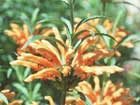
Lion's Ear
Scientific Name: Leonotis leonurus
Growth Habit: An upright to slightly spreading evergreen perennial growing to 6 feet tall and 3 feet wide. The leaves are narrow and lancelike, with scalloped edges, growing to 4 inches long and 3/4 inch wide.
Light: Plant in full sun to lightly shaded locations.
Feedings: Apply a general garden fertilizer once each in March, June and September.
Water Needs: Drought tolerant; water frequently until roots begin to grow into the surrounding soil, then every 7 to10 days.
Ease of Culture: Easy.
Propagation: From seeds or cuttings.
Hardiness: Tender; leaves and stems are damaged by frost and freezes, but plants usually grow back from buds near the ground.
Major Problems: Plantings occasionally are affected by chewing insects, but control is seldom needed. Avoid wet sites or excessive watering during the summer to prevent root rot problems.
Pruning: Plants make vigorous growth that needs pruning to remain attractive. During the growing season, the plants are best pruned after flushes of flowers decline to encourage more blooms. Prune heavily in late winter to remove cold damage and keep plants in bounds.
Uses: An attractive addition to the perennial and butterfly garden. Use as a backdrop for other lower-growing flowers or a stand-alone planting along walkways. The stems bear whorled clusters of tubular-shaped orange flowers that resemble a lion's ear. Another name is lion's tail because of the long tapering stems of blossoms.
Florida Native: No; native to South Africa.

Loquat
Scientific Name: Eriobotrya japonica
Growth Habit: An evergreen rounded tree growing to 25 feet tall and wide. Leaves are thick-veined, 3 to 4 inches wide and up to a foot long.
Light: Plant in full sun.
Feedings: Feed fruit-producing trees lightly once each in March and June with a 6-6-6 or similar analysis product.
Water Needs: Drought tolerant; keep young trees moist until roots develop into the surrounding soil.
Ease of Culture: Easy.
Propagation: Start from seeds from plantings. Named varieties usually are propagated by grafting on seedling root stocks.
Hardiness: Hardy; flowers and fruits are damaged by freezes.
Major Problems: Trees are susceptible to fire blight, a bacterial disease. Thin the canopy to allow air movement through the branches and feed lightly only once or twice a year to reduce the disease.
Pruning: Remove lower limbs as needed to allow landscape maintenance and movement under the branches. Periodic thinning of branches also can help control diseases.
Uses: Small trees for planting near a patio and along walkways, loquats also can be used as backdrops for flower beds and shrubs. The trees produce cream-colored clusters of blooms October through January. The flowers are followed by sweet and slightly acid-tasting fruits ripening January through April. Varieties Oliver, Tanaka and Wolf are recommended for fruit production.
Florida Native: No; native to China and Japan.
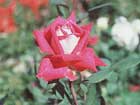
Love Rose
Scientific Name: Rosa hybrid 'Love'
Growth Habit: Upright to vase-shaped evergreen perennials growing to 6 feet tall and 4 feet wide. The leaves are compound with three, five or seven bright-green oval leaflets, each more than 1 inch long and wide.
Light: Grow in full sun.
Feedings: Apply a general garden fertilizer or rose special available from garden centers monthly March through November, every six weeks during winter.
Water Needs: Prefers a moist soil. Keep mulched and water every three to four days during dry times, less during the rainy season and cool weather.
Ease of Culture: Medium; frequent control of pests is needed.
Propagation: Roses can be started with seeds and cuttings and by grafting. Florida's bush-type roses normally are grafted on a vigorous root stock.
Hardiness: Hardy.
Major Problems: Black spot is a major leaf disease during damp weather, producing a dark spot often with a yellow halo on the foliage. Mites cause yellowing of the leaves during the dry times. Both pests produce major leaf loss that weakens the plants and should be controlled with natural or synthetic sprays available from garden centers.
Pruning: Give a major pruning during mid-February, removing one-third to one-half the length of each stem. Also remove twiggy and pest-affected portions. Groom throughout the year by removing faded flowers, seed heads and spindly branches.
Uses: Roses often are planted in beds for a major display and where the needs of a home collection can be easily provided. They also can be used as specimens in perennial gardens, shrub borders and container plantings. The flower range is extensive from white to yellow, orange and red. Love featured is a 1980 All-America Rose Selections winner with red and white petal portions.
Florida Native: No; a hybrid.

